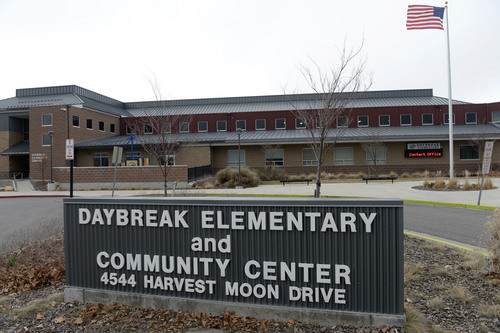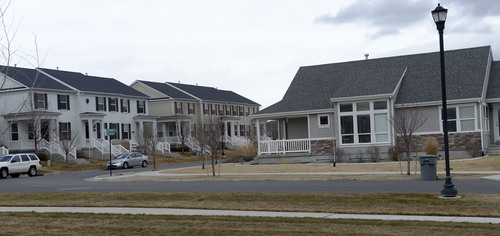This is an archived article that was published on sltrib.com in 2014, and information in the article may be outdated. It is provided only for personal research purposes and may not be reprinted.
South Jordan • Imagine more than 600,000 furnace pilot lights, one for each household on the Wasatch Front, each burning tiny amounts of fossil fuels 24 hours a day, seven days a week.
No single home or commercial building on the Wasatch Front is a gigantic polluter— not when compared with the region's smelter, power generators or oil refinery smokestacks. But, like car tailpipes, small inefficiencies in residential energy consumption scale up rapidly over the number of households.
State regulators estimate that as much as 25 percent or more of Utah's air pollution is linked to homes and buildings. ``There are so many of them,'' said Dave McNeill, manager of planning at Utah Division of Air Quality.
"People are just now barely starting to recognize the impact of their cars," McNeill said. "And that's easier to perceive than for them to realize what's going up their chimney or out of their water heater or their furnace."
As the Wasatch Front looks for answers to air quality, a residential development in South Jordan may offer insights. Daybreak was established 10 years ago by global mining behemoth Rio Tinto's subsidiary Kennecott Utah Copper, a top source of industrial air pollution in the Salt Lake valley.
Kennecott's Daybreak experiment in neighborhood formation, with its emphasis on sustainable master planning and reduced resource use, has swayed the state's debates on growth and development as well as on energy-efficient homes. Built on recovered land once used for mine evaporation ponds, Daybreak now is one of the fastest-growing communities in Utah.
But are its green-oriented concepts working and will they catch on? Or are the forward-thinking principles in the Daybreak plan tainted by the mining company's environmental legacy?
Kennecott has a unique legal partnership with the city of South Jordan that lets it set strict design, architectural and efficiency standards for a roster of home builders in the 4,127-acre community.
Daybreak's commercial buildings all are LEED certified, a green building and design standard. Its 3,800 residential units comply with the federal Energy Star system, which govern wise energy use on features ranging from home appliances to building standards.
Would-be Daybreak buyers also can compare homes based on a separate Home Energy Rating System, or HERS, where a score of 100 equals a standard new home. The system creates a market incentive to drive scores down, according to Daybreak's general manager, Ty McCutcheon.
Average Daybreak homes are 40 percent more efficient than their counterparts elsewhere and in some cases, up to 65 percent more efficient. "When you aggregate the impact of all those homes, it's quite significant," he said.
But let's say you're a homebuyer, with $5,000 for extras in your dream home. Do you spend on hardwood floors and granite counter tops or on a fuel-efficient heating and cooling system? A long-standing view among Utah's home builders: Most buyers choose the personal touches over saving the planet.
"Nobody really asks about it, to tell you the truth," said David Robison, a real estate agent who has sold more than 120 Daybreak homes since it opened in 2004. Instead, home buyers are more drawn by the appeal of Daybreak's houses and neighborhoods, its walkability and parks, he and others said.
But that is evolving, partly as consumers realize that saving energy also saves money. Many builders credit Daybreak with helping to turn energy efficiency into something Utah buyers value, as well as pushing out nontraditional concepts on housing design, higher density and conservation.
In Utah's home markets, "some of those ideas really started in Daybreak," said Bryson Garbett, president of Garbett Homes, a Salt Lake City-based builder of green housing. "Its requirements and attention to detail have raised the level of home building valleywide."
Twitter: @Tony_Semerad —
Daybreak: Answers to air pollution?
Daybreak is a residential and mixed-use development in South Jordan, built on a restored mine waste site by Kennecott Utah Copper on Salt Lake County's southwestern corner, at the foot of the Oquirrh Mountains. Begun in 2004, Daybreak follows a master plan for sustainable land use, conservation and energy efficiency, intended as a model for growth challenges faced across the Wasatch Front. —
Join the conversation
The Salt Lake Tribune seeks your input on stories about Daybreak and the lessons Utah can learn from it regarding air quality.
We're interested in your views on aspects of the South Jordan community and your neighborhood, on pollution-reducing ideas such as energy efficient homes, Energy Star and HERS standards, as well as housing density, green spaces and mass transit.
This story focuses on strategies to help home buyers cut pollution from houses, a top source of emissions in Utah's winter inversions. Other stories deal with how housing and neighborhood designs can reduce the need to drive and with the role of industrial polluters such as Kennecott.
What are your ideas for addressing Utah's air quality problems? Share comments, insights and experiences by emailing utairquality@sltrib.com. Please include your name and contact information.











